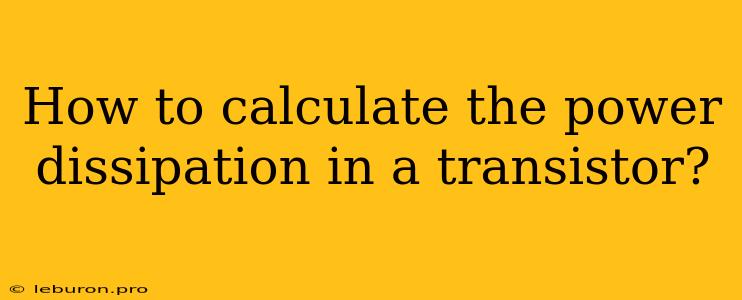Transistors are ubiquitous in modern electronics, forming the backbone of countless circuits. Their ability to amplify signals and switch currents makes them essential components in devices like smartphones, computers, and even household appliances. However, the efficient operation of a transistor relies heavily on understanding and controlling its power dissipation. Power dissipation in a transistor refers to the amount of energy it converts into heat during operation. This article will guide you through the process of calculating power dissipation in a transistor, highlighting the essential factors and providing practical examples.
Understanding the Fundamentals
Before delving into the calculation, it's crucial to grasp the fundamental concepts behind power dissipation in a transistor. The power dissipated by a transistor is primarily due to the following:
1. Collector-Emitter Voltage (VCE): The voltage drop across the collector-emitter junction directly contributes to power dissipation. A higher VCE leads to increased power loss.
2. Collector Current (IC): The current flowing through the collector is another key factor. As the collector current increases, so does the power dissipated.
3. Base Current (IB): While not as significant as VCE and IC, the base current contributes to a small amount of power dissipation.
4. Base-Emitter Voltage (VBE): The voltage drop across the base-emitter junction, though relatively small, also contributes to power dissipation.
Calculating Power Dissipation
The power dissipated in a transistor is calculated using the following formula:
Power Dissipation (P) = VCE * IC
This formula represents the power loss due to the voltage drop across the collector-emitter junction multiplied by the collector current.
Example:
Let's consider a transistor with a collector-emitter voltage of 10V and a collector current of 100 mA.
P = 10V * 100 mA = 1W
This calculation indicates that the transistor dissipates 1 watt of power in this scenario.
Factors Affecting Power Dissipation
Several factors can influence the power dissipation in a transistor:
- Transistor Type: The type of transistor, whether bipolar junction transistor (BJT) or field-effect transistor (FET), will affect its power dissipation characteristics.
- Operating Conditions: The operating temperature, load, and input signal can significantly impact power dissipation.
- Transistor Size: Larger transistors generally have a higher power dissipation capacity.
- Heat Sink: Using a heat sink can effectively reduce the temperature of the transistor, thus minimizing power dissipation.
Importance of Power Dissipation Calculation
Understanding and accurately calculating power dissipation is crucial for several reasons:
- Thermal Management: Excessive power dissipation can lead to overheating, which can damage the transistor or the surrounding components.
- Circuit Efficiency: Power loss due to transistor dissipation reduces the overall efficiency of the circuit.
- Circuit Design: Knowing the power dissipation characteristics of the transistor is essential for designing efficient and reliable circuits.
Practical Tips for Minimizing Power Dissipation
- Select the Right Transistor: Choose a transistor with a power rating that exceeds the expected power dissipation in your circuit.
- Use Heat Sinks: Employ heat sinks to dissipate excess heat and prevent overheating.
- Optimize Circuit Design: Minimize the collector-emitter voltage and collector current to reduce power dissipation.
- Ensure Adequate Ventilation: Provide sufficient airflow around the transistor to facilitate heat dissipation.
Conclusion
Power dissipation is a critical aspect of transistor operation that requires careful consideration during circuit design. By understanding the fundamental concepts and the calculation process, you can ensure efficient and reliable performance from your transistors. Remember to always consider the factors affecting power dissipation and take necessary precautions to minimize it. As a result, you can enhance the lifespan of your electronic devices and optimize the overall efficiency of your circuits.
